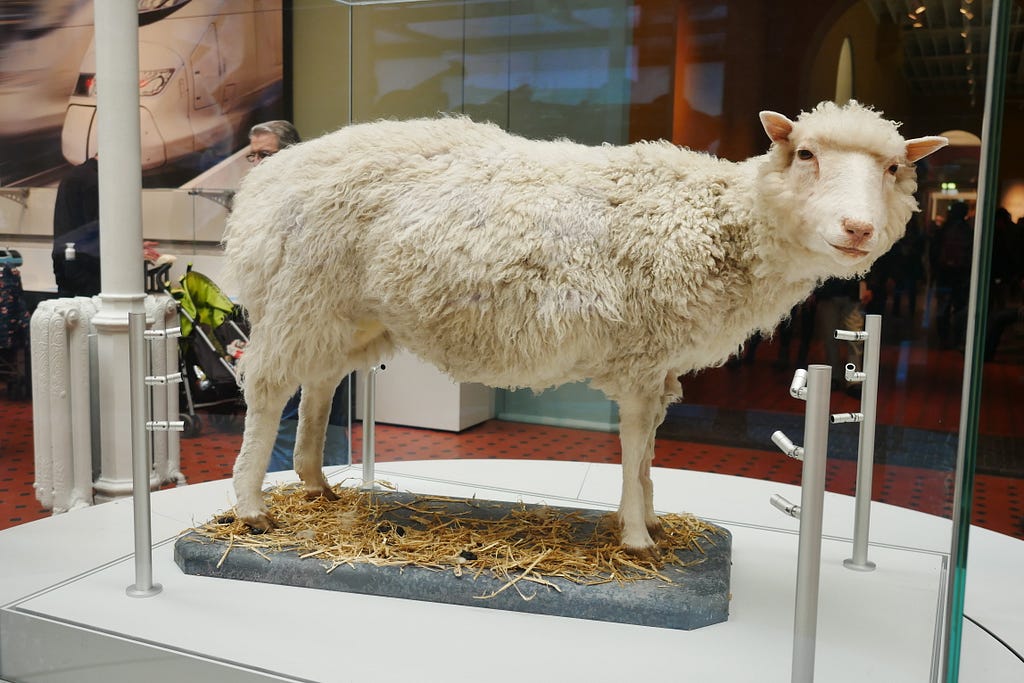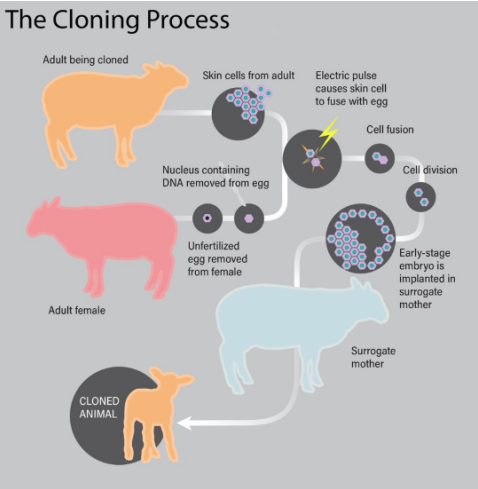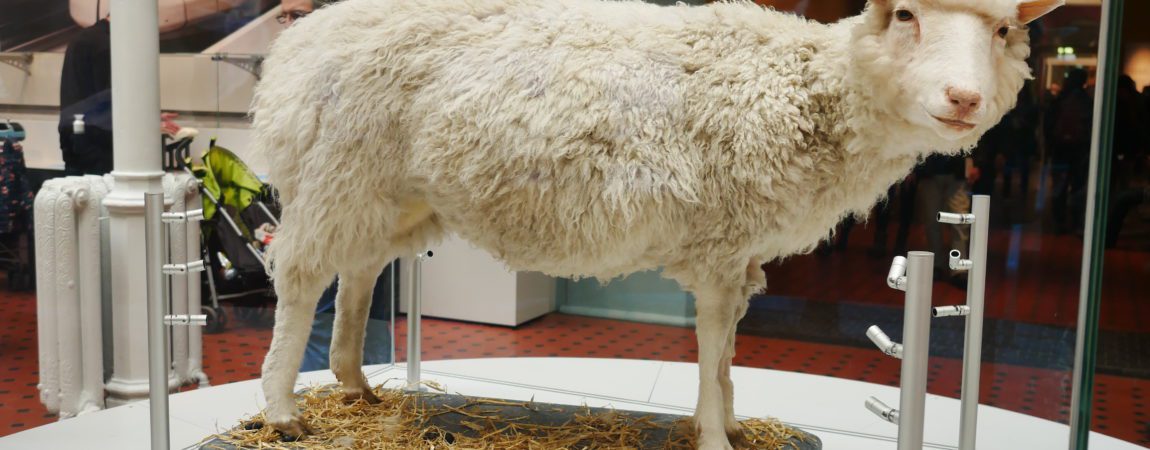Satomi Angelika Murayama, MEng ’20 (ME)
This op-ed is part of a series from E295: Communications for Engineering Leaders. In this course, Master of Engineering students were challenged to communicate a topic they found interesting to a broad audience of technical and non-technical readers.
“Sometime, somewhere, someone will generate a cloned human being.” — Ronald Green for Scientific American, 1999After Ian Wilmut and his colleagues at the Roslin Institute near Edinburgh in Scotland successfully cloned Dolly the sheep from the udder cells of an ewe in 1996, it became possible to envision having hundreds of cloned human babies in the very near future. Although this technology and the ongoing research to clone mammals (and thus humans) is at work in order to potentially cure certain diseases and give infertile couples the opportunity to have children, the topic of cloning humans has raised a lot of controversy as well as scientific, ethical and moral concerns. Just because we can does not mean that we should. Human beings should not be cloned for several reasons that are going to be further discussed in this op-ed: cloning is a risky, imperfect procedure, it does not create an exact copy of an individual, and it poses ethical concerns by using human beings as a means to an end, opening up possibilities for abuse and allowing eugenic selection.
Background on cloning
Before diving into the reasons and arguments of why humans should not be cloned, it is important to understand what therapeutic and reproductive cloning are. When we use the word “cloning” in our everyday life, most of us are thinking about having an identical-looking individual standing next to us. This is known as reproductive cloning and the technique is used today in order to improve livestock breeding (Weintraub, 2019). Reproductive cloning “involves creating an animal that is genetically identical to a donor animal through somatic cell nuclear transfer” (NYSTEM, 2019). Furthermore, in reproductive cloning, “the newly created embryo is placed back into the uterine environment where it can implant and develop,” which is not the case for therapeutic cloned cells (NYSTEM, 2019). Therapeutic cloning is used to produce embryonic stem cells in order to replace or repair damaged tissues or organs (“Therapeutic Cloning”, 2019). The diagram below summarizes the process of reproductive cloning.
The low success rate of cloning and its medical complications
Although many scientists claim that cloning will cure both common and rare and devastating diseases, such as diabetes and degenerative brain diseases in the human race, it has very low percentages of success and there are some medical concerns which cannot be overlooked. As Weldon writes: “Ninety-five to ninety-seven percent of animal cloning attempts still end in failure, and the scientists who cloned Dolly failed 276 times before they succeeded in producing a single live-born clone of an adult sheep” (Weldon, 2002). Moreover, most scientists believe that the process of cloning humans will result in even higher failure rates. Not only does the cloning process have a low success rate, the viable clone suffers increased risk of serious genetic malformation, cancer or shortened lifespan (Savulescu, 1999). The likelihood of pregnancy losses and abnormal births are very high, and this was observed by Wilmut and his team after cloning Dolly the sheep. They tried to clone another lamb in their lab, however the lamb “developed lung problems that caused it to hyperventilate and regularly pass out” (Weintraub, 2016).A mismatch of the public’s expectations with reality
Not only is the process of cloning very risky, but one of the biggest misconceptions that the general public has about this research is that a cloned individual will not be the same person as his or her donor. Although the donor and the clone will look exactly the same physically, as they have identical genomes, internally, they would be different individuals. The environment in which we grow up in and the experiences that we have throughout our life define us and shape us uniquely as individuals. As Weintraub writes: “We are all more than the genetic instruction manual that was involved in our creation” (Weintraub, 2019). We are all shaped by our environment from the day we were conceived (Weintraub, 2019). Even nature’s clones — identical twins — are not identical. They have the same genome but do not have the same personality, character, interests, style etc. They grow up to be different individuals. Furthermore, there is an even deeper misconception about cloning, thanks to all the science fiction books and movies. We need to realize that cloning would produce a baby, not an adult (Weintraub, 2019). There is a problem here. For example, if you were to clone a diseased loved one such as a spouse, you would probably want them to be your age when you replicate them, but this is impossible (Weintraub, 2019). If you were to clone yourself now, you would have to wait years for the clone to play catch up with you and grow to adulthood. Unless you are cloned at birth, there is no way, as of right now, for you to get a clone exactly at the same development stage as you. A clone grows into adulthood the same way as you and I grew into adulthood.“We need to realize that cloning would produce a baby, not an adult.”
The ethical and moral concerns that surround cloning humans
Finally, we cannot ignore the ethical and moral concerns that exist around the topic of human cloning. If the technology was legal, it could be abused and allow eugenic selections with enhancement in human traits. This comes with ethical and moral concerns as it would mean that we would be able to improve the human species by “selectively mating people with specific desirable hereditary traits” (“Eugenics — HISTORY”, 2019). Eugenics aim are to “breed out” diseases, “disabilities and so-called undesirable characteristics from the human population” (“Eugenics — HISTORY”, 2019). The practice of cloning would not only violate a person’s right to individuality but it would also “reduce diversity in the human gene pool” (Savulescu, 1999 and Green, 1999). Furthermore, as Savulescu puts it, cloning seems to be using “people as a means” and Green mentions fears that cloning will be used to “produce a subordinate class of humans created as tissue or organ donors,” much like in the movie “Never Let Me Go” (if you haven’t watched the movie, now is your time to do so). Cloning humans could lead to serious violations of human rights as well as human dignity, and it is up to authorities, laws and institutions to make sure to protect cloned individuals from being exploited (Green, 1999).“Cloning humans could lead to serious violations of human rights as well as human dignity, and it is up to authorities, laws and institutions to make sure to protect cloned individuals from being exploited.”
Concluding remarks
Although some scientists are working hard on cloning humans in order to cure diseases and help infertile couples, it is clear that the topic of human cloning has a lot of controversy medically and ethically. Some scientists are working on competitive technologies such as iPSCs (induced pluripotent stem cells), which “can be made to grow into any type of tissue in the body” in order to “make personalized multipurpose cells without destroying eggs or embryos,” and CRISPR gene editing, which do not require the development of an actual human. However, the topics of cloning and gene editing further open up controversial discussions about how this work could create more divides in the society between the rich and the poor (Weintraub, 2019). For example, there is the possibility of babies whose genes have been selected or altered, also known as “designer babies.” If we give scientists the ultimate power to clone humans, what terrifying things would they do next? What will our future look like? How far are we willing to go for science?About the author:
Satomi Angelika Murayama is a current Master of Engineering candidate at UC Berkeley studying Mechanical Engineering. Connect with Satomi.References
- “Eugenics — HISTORY.” October 28, 2019. Accessed November 1, 2019.
- Green, Ronald M. “I, Clone — Scientific American.” September 3, 1999. Accessed November 1, 2019.
- Savulescu, Julian. 1999. “Should we clone human beings? Cloning as a source of tissue for transplantation”. Journal of Medical Ethics. 25:87–95.
- “Therapeutic Cloning | Definition of Therapeutic Cloning at Dictionary.Com.” n.d. Accessed November 4, 2019.
- Weintraub, Karen. “20 Years after Dolly the Sheep Led the Way — Where Is Cloning Now? -Scientific American.” July 5, 2016. Accessed November 1, 2019.
- Weintraub, Karen. “Cloning’s Long Legacy — And Why It’ll Never Be Used on Humans|DiscoverMagazine.Com.” April 29, 2019. Accessed November 1, 2019.
- Weldon, Dave. “Why Human Cloning Must Be Banned Now | The Center for Bioethics & Human Dignity.” March 31, 2002. Accessed November 1, 2019.
- “What Is the Difference between Reproductive and Therapeutic Cloning? | NYSTEM.” n.d. Accessed November 1, 2019.
Op-ed: The dangers of cloning was originally published in Berkeley Master of Engineering on Medium, where people are continuing the conversation by highlighting and responding to this story.


